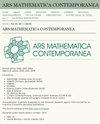Normal Cayley digraphs of dihedral groups with CI-property
IF 0.9
3区 数学
Q3 MATHEMATICS
引用次数: 0
Abstract
A Cayley (di)graph $Cay(G,S)$ of a group $G$ with respect to $S$ is said to be normal if the right regular representation of $G$ is normal in the automorphism group of $Cay(G,S)$, and is called a CI-(di)graph if there is $\alpha\in Aut(G)$ such that $S^\alpha=T$, whenever $Cay(G,S)\cong Cay(G,T)$ for a Cayley (di)graph $Cay(G,T)$. A finite group $G$ is called a DCI-group or a NDCI-group if all Cayley digraphs or normal Cayley digraphs of $G$ are CI-digraphs, and is called a CI-group or a NCI-group if all Cayley graphs or normal Cayley graphs of $G$ are CI-graphs, respectively. Motivated by a conjecture proposed by \'Ad\'am in 1967, CI-groups and DCI-groups have been actively studied during the last fifty years by many researchers in algebraic graph theory. It takes about thirty years to obtain the classification of cyclic CI-groups and DCI-groups, and recently, the first two authors, among others, classified cyclic NCI-groups and NDCI-groups. Even though there are many partial results on dihedral CI-groups and DCI-groups, their classification is still elusive. In this paper, we prove that a dihedral group of order $2n$ is a NCI-group or a NDCI-group if and only if $n=2,4$ or $n$ is odd. As a direct consequence, we have that if a dihedral group $D_{2n}$ of order $2n$ is a DCI-group then $n=2$ or $n$ is odd-square-free, and that if $D_{2n}$ is a CI-group then $n=2,9$ or $n$ is odd-square-free, throwing some new light on classification of dihedral CI-groups and DCI-groups.具有ci -性质的二面体群的正规Cayley有向图
Cayley (di)图 $Cay(G,S)$ 一组的 $G$ 关于 $S$ 如果说正态如果是正确的正则表示 $G$ 的自同构群中的正规是 $Cay(G,S)$,若有,则称为CI-(di)图 $\alpha\in Aut(G)$ 这样 $S^\alpha=T$,每当 $Cay(G,S)\cong Cay(G,T)$ 对于Cayley (di)图 $Cay(G,T)$. 有限群 $G$ 被称为dci群或ndgi群如果所有的Cayley有向图或正常的Cayley有向图 $G$ 都是ci -有向图,它被称为ci -群或nci -群如果所有的Cayley图或正规Cayley图是 $G$ 分别为ci图。在1967年Ádám提出的一个猜想的推动下,ci -群和dci -群在过去的五十年里被许多代数图论研究者积极地研究。环状ci -群和dci -群的分类历经了大约30年的时间,最近,前两位作者等对环状nci -群和ndci -群进行了分类。尽管对二面体ci群和dci群有许多不完全的结果,但它们的分类仍然难以确定。本文证明了一个有序的二面体群 $2n$ 是nci组还是nci组当且仅当 $n=2,4$ 或 $n$ 很奇怪。直接的结果是,如果是一个二面体基团 $D_{2n}$ 有序的 $2n$ 那是dci组吗 $n=2$ 或 $n$ 奇平方是自由的,是吗 $D_{2n}$ 那是ci组吗 $n=2,9$ 或 $n$ 是奇方无的,这为二面体ci群和dci群的分类提供了一些新的线索。
本文章由计算机程序翻译,如有差异,请以英文原文为准。
求助全文
约1分钟内获得全文
求助全文
来源期刊

Ars Mathematica Contemporanea
MATHEMATICS, APPLIED-MATHEMATICS
CiteScore
1.70
自引率
0.00%
发文量
45
审稿时长
>12 weeks
期刊介绍:
Ars mathematica contemporanea will publish high-quality articles in contemporary mathematics that arise from the discrete and concrete mathematics paradigm. It will favor themes that combine at least two different fields of mathematics. In particular, we welcome papers intersecting discrete mathematics with other branches of mathematics, such as algebra, geometry, topology, theoretical computer science, and combinatorics. The name of the journal was chosen carefully. Symmetry is certainly a theme that is quite welcome to the journal, as it is through symmetry that mathematics comes closest to art.
 求助内容:
求助内容: 应助结果提醒方式:
应助结果提醒方式:


